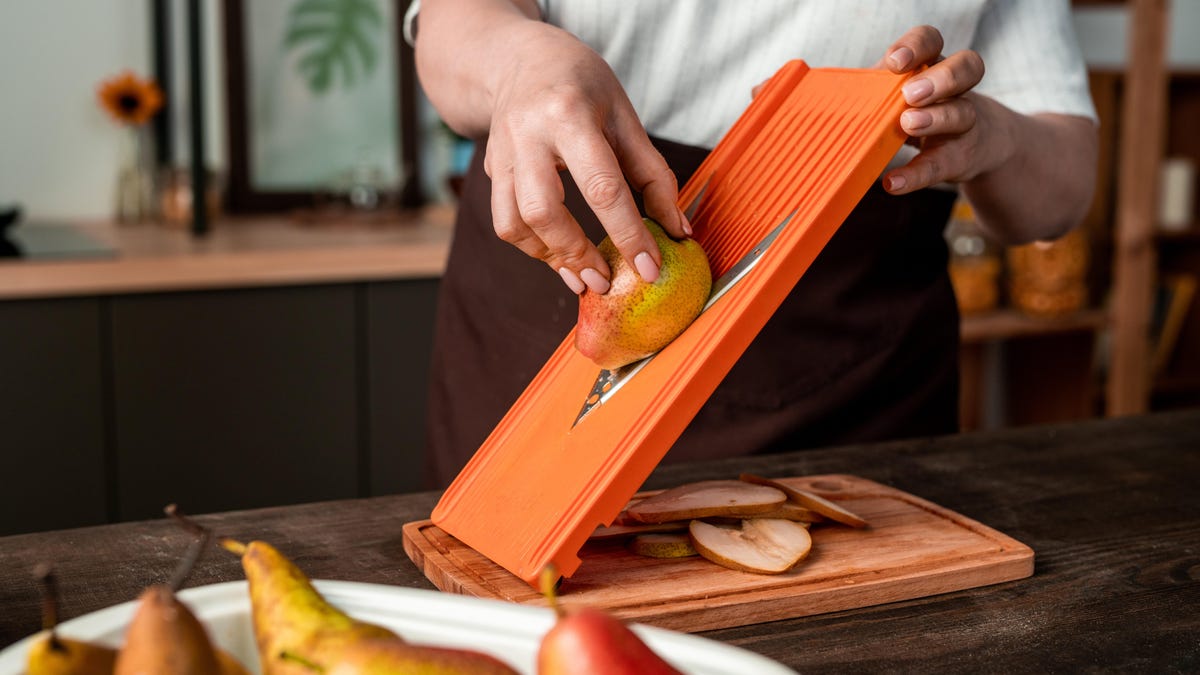A Mandoline Slicer Will Make You a Better Cook
Mandoline slicers have a scary reputation. And yes, they’re sharp as heck, and can do major damage if you don’t respect the blade. But inviting one into your kitchen is one of the easiest ways to cut down on...

Mandoline slicers have a scary reputation. And yes, they’re sharp as heck, and can do major damage if you don’t respect the blade. But inviting one into your kitchen is one of the easiest ways to cut down on prep time and improve your cooking.
One of the easiest ways to tell a real-deal chef from an amateur is to look at their slicing and dicing. Uniform cuts look professional, but they also ensure ingredients cook at the same rate and are seasoned or dressed evenly, with each slice of zucchini or cube of potato receiving the same amount of love. And while everyone should take the time to learn basic knife cuts, a mandoline can help you achieve professional looking slices, matchsticks, and cubes much more quickly. Not only will your sandwiches, salads, and side dishes look more polished, but they will taste better, resulting in you eating more vegetables (and perhaps a few more fruits, as well).
But first, a note on safety
Mandoline slicers come in many different shapes and sizes, but they all have one thing in common: extremely sharp blades. These blades are housed in a plastic frame, and it kind of looks like the world’s most painful plastic slide. To use the slicer, you slide the food down the plastic ramp and over the blade, which, depending on the blade you’re using, cuts the vegetable into a paper thin slice, a julienned matchstick, or—in some cases—a waffle fry.
But if your hand slips on the slide, and you aren’t using a guard or wearing a cut-resistant glove, you can wind up with a horrific injury. If your mandoline comes with a guard, use it, but otherwise: Get a protective glove and put it on your hand.
In addition to wearing the proper PPE, there are other steps you can take to cut down the risk of injury, like making sure the slicer is stable, cutting your food into manageable portions before slicing, and keeping the blade sharp (dull blades require more force to cut, and that’s often where you run into trouble).
Choosing a mandoline slicer
I’ve used elaborate slicer systems with lots of attachments, but my current (and favorite) mandoline is the Benriner vegetable slicer, a rudimentary slicer that’s adjusted with a few simple screws.

In addition to a straight blade, it comes with a few attachments for making julienne cuts and shredding. It also comes with a little plastic guard which, again, you really should use. It’s easy to clean and store, and affordable—usually in the $30-$40 range, depending on where you buy it.
If the idea of a tiny little plastic guard makes your nervous, there are plenty of slicers with more substantial guards, like this one (which comes with a kick-out stand), or this handheld slicer, both from OXO. If you wish to keep your fingers entirely out of harms way, you can get a slicer with a safety shoot, like this one from Once for All. If none of those tickle your fancy, take a look at some of the most recent suggestions from The Spruce Eats, which has quite a few.
Creative ways to use a mandoline slicer

Photo: Claire Lower
Slicing vegetables before cooking is the most obvious use for the mandoline slicer, but once you have one in hand, you’ll find yourself slicing and dicing all sorts of foods. Here are some of my favorite uses for the tool, in no particular order:
Build better a better submarine (sandwich): Making a good sandwich is all about balancing flavor and texture, which is why I like my lettuce shredded and my onions sliced paper thin. You can accomplish both with a mandoline. Bonus: You’ll shed fewer onion related tears, as the slicer is faster and sharper than most knives, and less exposure time and cleaner cuts means less syn-Propanethial-S-oxide (the compound responsible for your tears) is released into the air. And don’t forget the fruits: A thinly sliced pear or apple is absolutely heavenly on a brie-based grilled cheese.Make tastier salads and slaws: I cannot not abide a salad bowl filled with uneven chunks of vegetables. A mandoline lets you slice cucumbers into paper thin ribbons, shred cabbage for slaw, and—depending on the available attachments—cut potatoes into perfect cubes for potato salad. Uniformity may not seem like such a big deal when you’re tossing everything into a big mixing bowl, but accurate slicing means each piece is coated with an even amount of dressing, which translates to a uniform texture and flavor.Pickle uniformly: Whether you’re pickling onions or cucumbers, slicing them with a mandoline will ensure even thickness from slice to slice, so each one pickles at the same rate.Make your own chips, be they potato or apple: I’m not saying you can’t use a knife to slice potatoes as thinly as Frito-Lay, but you can do it a lot faster and more consistently with a mandoline. In addition to the classic potato chip, you can use your slicer to turn any root vegetable (and some squashes) into a chip, or prep fruit for the dehydrator.Slice crumbly cheeses: Aged cheddars and other crystal-flecked beauties can crumble under the pressure of a knife, but a mandoline turns out thin, deli-worthy slices.Make prettier charcuterie boards: You can use a mandoline to slice salami (or any firm sausage or salumi) into pleasing slices that look pretty on a board, but my favorite meat to mandoline is the dried out steak, which slices into pretty little petals that melt into a soft scramble and sit pretty on crostini.Mandoline slicers are also just plain fun to use. They feel chef-y, make your food look pretty, and help you ensure everything cooks at an even, predictable rate. Just please make sure to use the guard, or at least a glove. A little danger might seem fun, but a sliced hand decidedly isn’t.

 Fransebas
Fransebas 
































